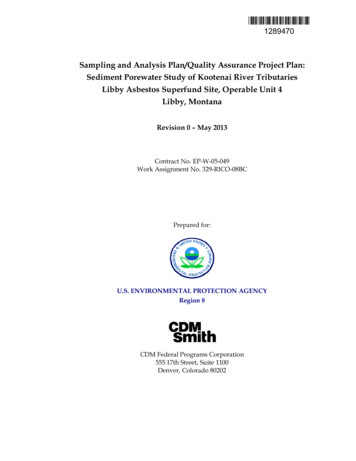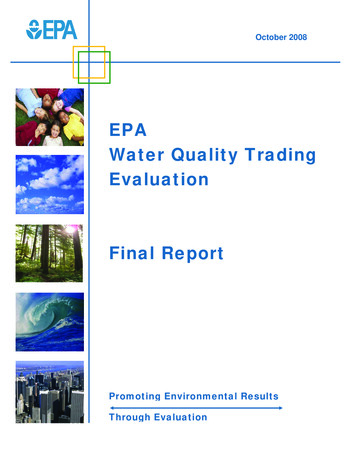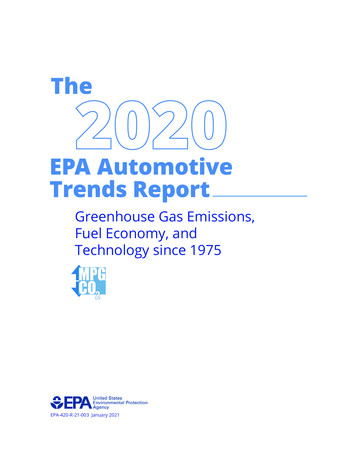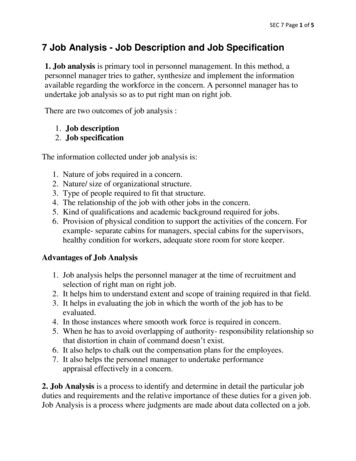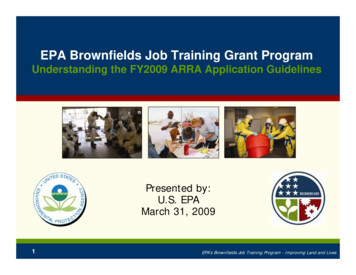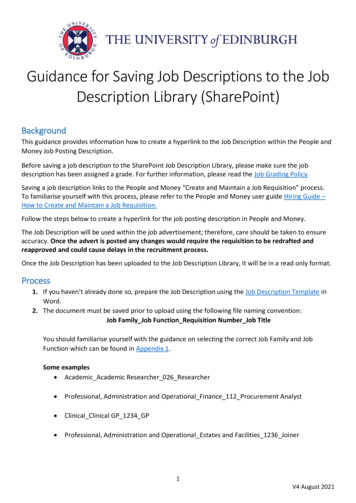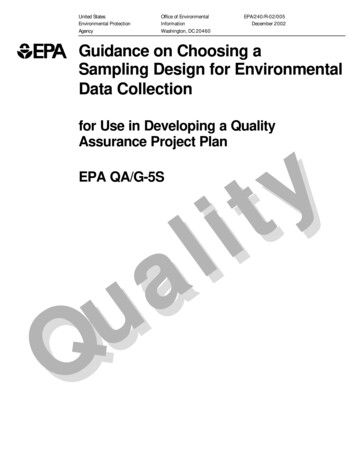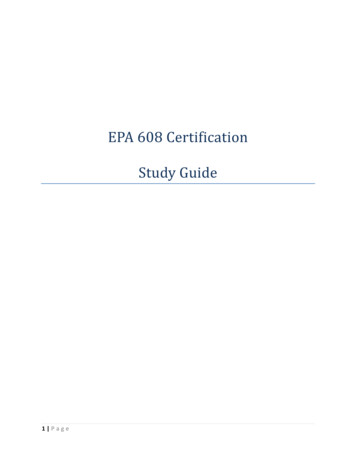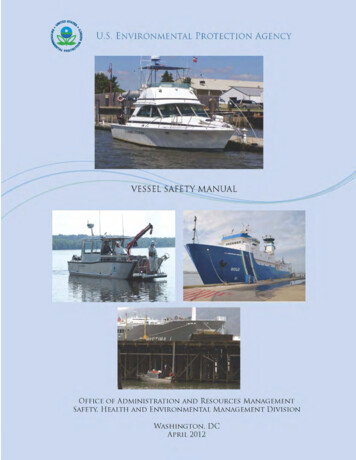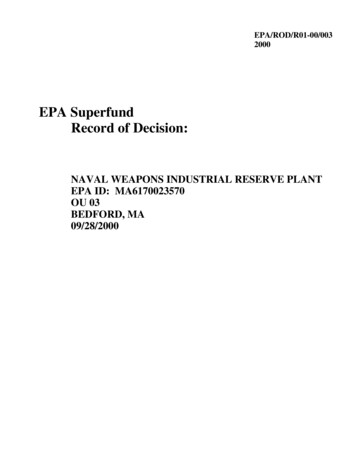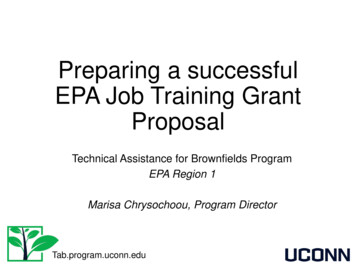
Transcription
Preparing a successfulEPA Job Training GrantProposalTechnical Assistance for Brownfields ProgramEPA Region 1Marisa Chrysochoou, Program DirectorTab.program.uconn.edu
Your EPA Region 1 JT contactWilliam LariviereJob Training CoordinatorBrownfields Project ManagerEPA Region-1Office: 1 (617) 918-1231Lariviere.William@epa.gov
Webinar ObjectivesPresent RFPguidelines (EPAJune 15th webinarwill do that)Guidance on howto addressguidelines – grantwriting tips
First Rule of Grant Writing
Where is the rubric?Page 29 of theFY23 JT RFA
1. COMMUNITY NEED (35 points)Overview ofsectionsand points 1.A. Community Description (20 points) 1.B. Labor Market Demand (15 points)2. TRAINING PROGRAM DESCRIPTION (20 points)3. BUDGET (10 points)4. PROGRAM STRUCTURE, ANTICIPATED OUTPUTS ANDOUTCOMES (45 points)Length ofsection shouldbe roughlyproportional topoints 4.A. Outputs and Outcomes (10 points) 4.B. Recruitment and Screening (20 points) 4.C. Program Support (10 points) 4.D. Program Sustainability (5 points)5. COMMUNITY AND EMPLOYER PARTNERSHIPS (40points) 5. Partnerships (10 points) 5.A. Collaboration with Environmental Entities (5 points) 5.B. Collaboration with Job-Readiness/Life Skills (5 points) 5.C. Collaboration with Community (5 points) 5.D. Collaboration with Employers (15 points)6. LEVERAGING (5 points)7. PROGRAMMATIC CAPABILITY (30 points) 7.A. Grant Management System (5 points) 7.B. Organizational Experience (10 points) 7.C. Audit Findings (5 points) 7.D. Past Performance and Accomplishments (10 points)
Considerations to define yourTarget AreaScope andreach of yourorganization(city, regional,county)CommunityNeed –Justice40InitiativeSufficient sizefor targetnumber oftrainees, jobsandemployers
1A Community DescriptionDemographics(race andethnicity, lution, health,economic data)
Disadvantaged community Definition underJustice40Initiative WatchEJSCREENvideo to obtainrelevantindicators https://tab.program.uconn.edu/workshopswebinars/
Community NeedMay replace one columnwith EPA Region 1 if TargetArea is City or County wideReplacewith newerdata ifnewerversion isusedHigh school graduation ratesSpecific minority groups
Data for Community Need Watch video on using American Fact Finder onhttps://tab.program.uconn.edu/grant-writing/ Selected ACS 2020 data are also available, downloadedfor New England states Watch EJSCREEN video to obtain additional parametersto establish EJACS 2020 5-yearPopulationUSACTMAMENHRI326,569,308 3,570,549 1,340,825 6,873,003 1,355,244 5.5%3.8%Poverty Rate12.8%9.8%11.1%9.8%7.4%11.6%10.8%Median Household %38%5%31%9%33%6%Percent MinorityNote: Percent minority is equal to percent non-white plus percent Hispanic
1B Labor Market Demand Department of Labor Information related to New EnglandStates https://www.bls.gov/regions/new-england/ State data (some also have regional data available)RegionalMarketLaborInformationMA LaborMarketInformationCenter forWorkforceResearchandInformationEconomicand LaborMarketInformationBureauRI LaborMarketInformationVTEconomicand LaborMarketInformation
Labor Market Demand –Additional ToolsInterviewsMay also use paid services such as Chmura
Identifying Environmental EmployersLicensed EnvironmentalProfessionalsAsbestos and Lead ContractorsWaste Transporters and SpillContractorsLicensed Site ProfessionalsAsbestos ContractorsLead Abatement ContractosHazardous Waste TransportersLicensed Asbestos AbatementConsultantsHazardous Waste and Waste OilTransportersAsbestos ContractorsLead assessors and contractorsHazardous Waste Vendor listsDEM Environmental consultant listAsbestos ContractorsLead contractorsHazardous Waste TransportersVTDEC Consultant ListVTDEC Cleanup Contractor ListAsbestos ContractorsLead Contractors
2 Training Program Description Number and types of courses offered Course provider Level of training Certification Duration Number of cycles program will be offered Cost per course
Training Program ElementsMandatory 40-hour HAZWOPEREligible Wide-array of “green jobs” – relate them to brownfields Pages 2-3 of RFA Also see Brownfields Toolbox Best Practices documentSupplemental (NOT eligible for EPA funds) Life skills, Adult literacy and employability Can provide in collaboration with other entities but NOTpart of main training program
Eligible course highlightsGreeninfrastructure Stormwatermanagement Renewableenergy,energyefficiencySoil/Agriculture Horticulture/ecologicalrestoration Landscaping UrbanagricultureClimate andEmergency Disasterworkercertification Firstresponder Climateresilienceawareness
Key considerations in building theprogramSkills must be tied tooutcomes of LaborMarket DemandSection, i.e. employerneedsSkills must addressCommunity Need andprofile – if possible, tieto specificredevelopment efforts
Content Providers – You don’t have togo it adeSchools
3 BudgetCertain participant support costs ARE NOW ELIGIBLE FOR NEWGRANTEES, including for: Transportation for trainees for site visits during training or totransport trainees to and from class in the form of stipends orother allowable direct costs (e.g. transportation vouchers orvehicle rental). Reasonable stipends to compensate trainees for participating intraining. Note that stipends may only be paid for actual time spentin training classes or on-the-job training activities and must notduplicate training support provided through other Federal, state,tribal or local programs. Reasonable child-care subsidies. Note that child-care subsidiesmust not duplicate child-care support provided through otherFederal, state, tribal or local programs.MAX 40% of total budget
4A Outputs and OutcomesOutputs (Measurable – short term) Outcomes (long term – related toCommunity Need)Number of students (min. 50completing)Increased community access toenvironmental jobsJob placement rate (min. 70%)Enhance labor availability for greenjobs in EJ communitiesNumber of trainingsImprovement communityinvolvementNumber of certificationsPromote Environmental health andsafetyNumber of individuals withHAZWOPER certificationReduce exposure to hazardoussubstances
4B Student recruitment strategy –potential outreach partnersVocational high schoolsLocal labor union chaptersVeteran’s Service DepartmentsChambers of CommerceCommunity organizations, churchesRe-entry programs
4B Screening processes –potential elementsRequirementsAge 18 or 17 with high school diploma and parental consentProof of legal work authorizationPossessing (or being able to obtain) driver’s licenseHigh school diploma or GED (may be optional)InterviewVocational interest questionnaireTest for Adult Basic Education (basic math, verbal and languagecommunication skills), English language skillsPhysical limitations for certain trainings or jobsAbility to consistently attend trainings, e.g. family obligations,transportation
4B Retention and AttritionStrategiesIdentify barriers to completion earlyonAdvising/mentoring/check-insthroughout the programSolicit feedback during program, notonly upon completionFlexibility to complete program indifferent cycles
4C Program SupportSupported by EPAgrant Job placementand referral Follow-up andreemployment Student trackingExtra (notsupported by EPAgrant) Life skills Mentoring Legal, mentalhealth, personalissues
4C Program Support - Tax Credits Work OpportunityTax Credit Federal taxcredit availableto employers whoinvest inAmerican jobseekers whohave consistentlyfaced barriers toemployment.
5 Partnerships – make sure yourpie is complete Recipients ofbrownfield grants Economicdevelopmentagencies Citizen groups Churches High schools WorkforceDevelopment Boards,One Stop Centers,trade schools,community collegesAEnvironmental(placement, onthe job training)B Jobreadiness(SupplementalTraining)C Community(Recruitment)D Employers(placement, onthe-job training) Environmentalconsultants andcontractors, laborunions, developers,hazardous wastecompanies
Brownfield grantees in NewEngland https://java.epa.gov/acrespub/gfs/ Apply filters, EPA Region 1, State, GrantAnnouncement past 3 years
Additional Resources Brownfields Toolbox: one-stop site for allissues on JT grants: best-practices documents,webinars, listserv EPA JT website: June 15th webinar, guidelines,FAQ UCONN TAB website: webinar recording,related files – Contact us for a review of yourproposal!
Questions?
Marisa Chrysochoou, Program Director Tab.program.uconn.edu . Your EPA Region 1 JT contact William Lariviere Job Training Coordinator Brownfields Project Manager EPA Region-1 Office: 1 (617) 918-1231 Lariviere.William@epa.gov. Webinar Objectives Present RFP guidelines (EPA June 15th webinar will do that)
